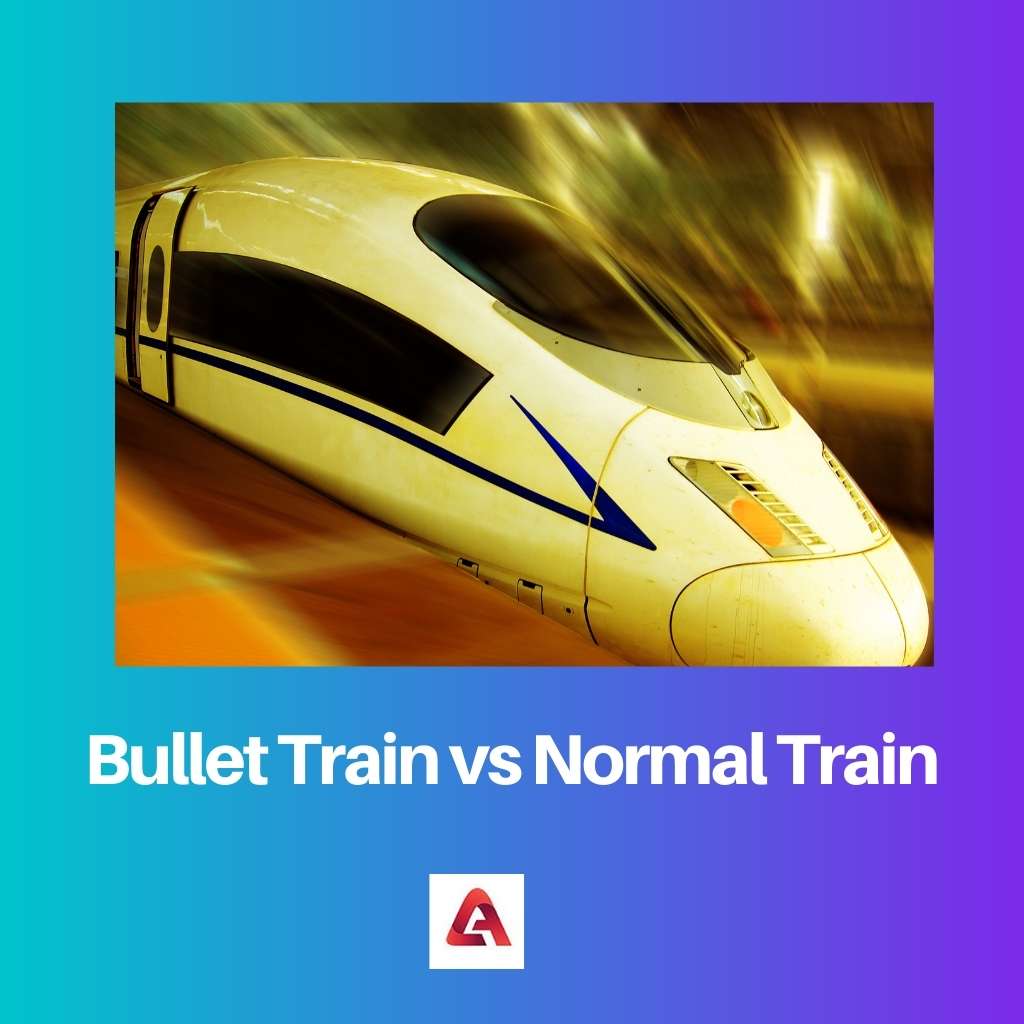Trains have been a famous method of transportation for a long time. The primitive steam train to normal train and then to the Bullet Trains.
The primary function of trains is to migrate people from one place to another in a dedicated time. Normal Trains are most popularly used by the people as compared to the Bullet trains.
Key Takeaways
- Bullet trains, also known as high-speed trains, travel significantly faster than normal trains, reaching speeds up to 220 mph.
- Bullet trains utilize advanced technologies for improved aerodynamics, efficient power systems, and sophisticated track designs.
- Normal trains serve a wider range of routes and are more affordable for passengers, while bullet trains operate on specific high-demand routes and require higher ticket prices.
Bullet Train vs Normal Train
Bullet train a type of rail system that operates at a faster pace than traditional rail. It is based on magnetic levitation and moves at a speed of 250 kmph or above. A normal train runs on a ballasted track with speed ranging between 160 Kmph to 200 kmph and have a higher number of stoppages.

Trains that move at a speed of 250 Kmph or above are referred to as Bullet Trains. Usually, these trains have a design like an aerodynamic to cut the air when they move at high speed, which is essential for high-speed trains.
Bullet Trains are luxurious and costly and can cover a large distance in a very short time.
The trains that run on the normal tracks and have a speed of around 160 Kmph, and for some situations, a speed of 180kmph is referred to as the Normal Trains. These trains are widely used in every country as their main transportation for large distances.
They are cheap as compared to the Bullet Trains.
Comparison Table
| Parameters of Comparison | Bullet Train | Normal Train |
|---|---|---|
| Speed | 250 to 280 Kmph | 150 to 180 Kmph |
| Ticket Price | Costly | Cheaper |
| Length | They are small with 4-5 Coaches | They are long with 20-25 Coaches |
| Infrastructure | Only Seating with Chair car | Both Seating and Sleeper |
| Stoppages | Normally 1 to 2 stops only | Stops can range from 15-20 depending on the distance how far the train is traveling |
What is Bullet Train?
Bullet Trains sometimes referred to as the High-Speed Rail, is a sort of rail transport that runs altogether quicker than other rail traffic.
These trains run on a highly specialized track known as high-speed tracks, which are only preferred for trains speeding up to 250+ Kmphr.
Bullet trains are highly advanced technology. They get their name from their design like a bullet which is basically an aerodynamic design that is preferred for high speed.
These trains have two engines, one at the front and the other at the backward. Once the train reaches the station, there is no changing of engines.
To move in the opposite direction, the driver sits in the back engine, which moves the train in the opposite direction.
Bullet Trains are preferred for long distances as they can cover a large distance in a small time frame. Due to its advanced technology, the price of the fare is high as compared to the Normal Trains.
Bullet Trains are not functioning in all the countries as they require a different track as compared to the Normal Trains. These trains have luxurious seating chairs which provide the customers a relief when the train is running at its high speed.
The trains have a belt on every seat, like an airplane which is used to buckle the person when it is starting as it gives a small jerk once it starts.

What is Normal Train?
Normal Trains are in use for a long time since the trains running on Steam Engines have stopped. Almost all the countries in the world have this type of transportation for their people.
These trains run at a speed of 150-180Kmph, hence as their low speed, it takes more time as compared to the Bullet Trains for covering the distance.
Normal Trains uses a normal track for running, which is called a broad gauge. These tracks are not preferable for speeds like 250Kmphr.
These trains have a moderate infrastructure. Also, they have a sleeper class and chair car both for traveling as compared to the Bullet trains, which have only chair cars.
Traveling in these trains is tough, as only some coaches have the AC facility whereas the other coaches are window one. Normal Trains at a time can migrate 1000+ people at a time to different places.
As these trains run at a slow speed because it has many stations, If the distance is very long, it can have 15-20 stations which increase the time for traveling. Engines in these trains get power from either Diesel or Electric, depending on the area where the train is departing.

Main Differences Between Bullet Train and Normal Train
- Bullet Trains run at a speed of 250+Kmphr whereas Normal trains are slow and run at a speed of 150Kmphr
- Normal Trains are equipped with both Sleeper and Chair Car classes, whereas Bullet Trains, due to their high speed, are equipped only with Chair Car.
- Bullet Trains are fully air-conditioned as compared to the Normal Trains in a while. Only a few coaches are air-conditioned.
- The fare price of Bullet Trains is way high as compared to the Normal Trains.
- At a time, Bullet Train can migrate fewer people as compared to the Normal Trains as Bullet Trains have fewer coaches (4-5) than to Normal Trains, which has 20-25 coaches at a time.





